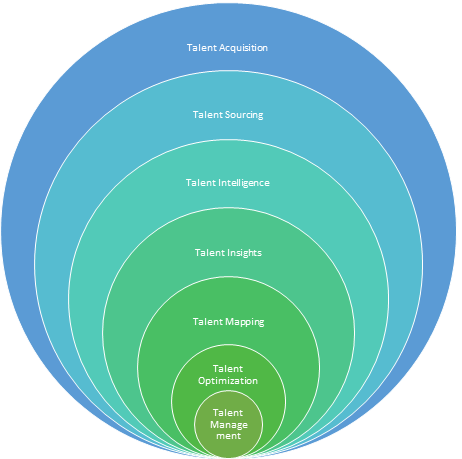In the HR world, we've been evolving with global trends and responding to business needs to stay fresh and relevant. As a result, we've documented what's called the talent ecosystem - a term that encompasses new aspects of talent intelligence, talent marketplace, talent optimization, talent management, talent mapping, talent insights, talent sourcing, talent acquisition, and talent mobility. But with all these terms proliferating, it can be confusing to know what they mean and how they're related. In this post, I'll try to define the difference between all of these terms and explain their logical connections.
The most important function of the talent ecosystem is to help organizations find, hire and retain the best talent possible. By using data and analytics, these functions can help companies identify where the best talent is located, assess employee performance, and create development plans. This allows organizations to find and recruit the best employees available and improve their talent-related business processes.
The talent ecosystem is closely related to diversity and equity (DEI). Enhancing the talent acquisition function with new aspects of talent intelligence, talent marketplace, talent optimization, talent management, talent mapping, talent insights, talent sourcing, and talent mobility can help organizations identify and hire a more diverse and equitable workforce. Furthermore, creating a more diverse and equitable workplace is essential to building an innovative and successful organization. The talent ecosystem helps organizations create a more diverse and inclusive workplace by providing a way to identify and assess talent from all backgrounds. It also helps organizations connect with a larger pool of talent, which can be beneficial for recruiting and retaining a more diverse workforce.
First, the Definitions
-talent intelligence: the process of gathering, analyzing, and using data to make better talent decisions. This includes using data to understand what talent is available, where it is located, and how it can be best used.
- talent management: the process of organizing and managing talent within an organization. This includes activities like recruiting, hiring, onboarding, training, developing, and managing employees.
- talent optimization: the use of data and analytics to identify and optimize the best talent practices for an organization. This includes activities like matching jobs with the best candidates, assessing employee performance, and creating development plans.
- talent marketplace: a platform where organizations can find and hire talent. This includes platforms like LinkedIn or Indeed that allow companies to post jobs and search for candidates.
- talent mapping: the process of identifying and tracking the movement of talent across an organization or industry. This includes tracking where employees are coming from, where they are going, and what skills they are bringing with them.
- talent insights: the use of data to understand how talent is being used within an organization. This includes activities like understanding which skills are in high demand, identifying employee engagement trends, or predicting turnover rates.
- talent sourcing: the process of finding and recruiting talented individuals from outside an organization. This includes activities like searching job boards or social media for potential candidates or contacting staffing agencies.
- talent acquisition: the process of acquiring new employees into an organization. This includes activities like recruiting, screening, interviewing, and hiring new employees.
- talent mobility: the ability of employees to move between jobs within an organization or between organizations. This includes activities like transferring between departments or moving to a different company altogether.

How do these functions interact?
- talent management and talent optimization are two closely related functions. Talent management is the process of overseeing the development and performance of employees, while talent optimization is the improvement of talent-related business processes to achieve better performance.
- talent intelligence, talent mapping, and talent insights are all ways of gathering data about talent. Talent intelligence refers to the collection and analysis of data to help identify and understand talent-related trends. Talent mapping is the creation of a visual representation of where an organization's talent is located. Talent insights are analyses of data that provide insights into how to improve talent management practices.
- talent sourcing, talent acquisition, and talent mobility are all concerned with bringing new talent into an organization. Talent sourcing is the process of finding potential candidates for a job opening. Talent acquisition is the process of formally hiring a candidate. And talent mobility is the ability to move employees freely between jobs within an organization or between organizations.
Where does employee retention fit into the talent ecosystem?
Employee retention is a critical part of the talent ecosystem. It's what ensures that the talent we've acquired remains with us and continues to contribute to our business. Talent management and talent optimization are key components of employee retention, as they help us ensure that our employees are happy and productive. And talent intelligence helps us understand what makes our employees happy and productive, so that we can continue to improve our talent management and optimization strategies.
Talent management is the process of overseeing the development and performance of employees, while talent optimization is the improvement of talent-related business processes to achieve better performance. talent intelligence: the process of gathering, analyzing, and using data to make better talent decisions. This includes using data to understand what talent is available, where it is located, and how it can be best used. talent mapping: the process of identifying and tracking the movement of talent across an organization or industry. This includes tracking where employees are coming from, where they are going.
What is the most critical function?
The central function is talent management. Talent management oversees the development and performance of employees, ensuring that they are meeting the needs of the organization. This function is critical to the success of an organization and should be given the attention it deserves.
Talent management oversees and coordinates the talent acquisition process, talent sourcing, talent intelligence, and talent insights. It also works closely with talent optimization to ensure that the best talent practices are in place. By working together, these functions create a comprehensive system for finding, developing, retaining and using talent to the best effect possible.




